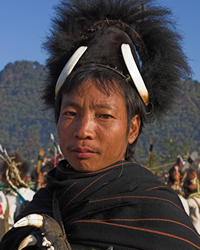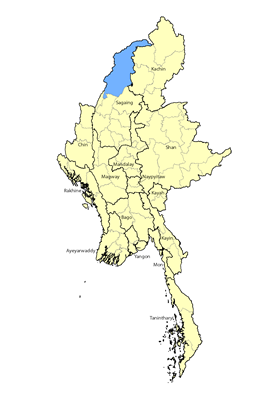The Cyolim people proudly retain their culture and enjoy singing traditional songs that tell the story of their journey as a people. On the Indian side of the border the Cyolim are better known as Cholim or Tonglim. They first moved to India in the first half of the 20th century and numbered just 72 people at the time of the 1981 Indian census. Although they are still in Assam, they have officially vanished from records in recent decades and the Indian government now likely counts them under the generic Tangsa label.
Location: The tiny Cyolim tribe, numbering about 900 people, inhabit only a few villages in northwest Myanmar's Sagaing Region. Their two largest villages appear to be Hulong (25 households) and Khamtai (19 homes) near the town of Pangsau in Lahe Township. Many communities in the area are mixed, with families from several tribes living in a single village, so it is difficult to obtain a precise population for groups like the Cyolim. Pangsau is nestled among rugged forested mountains near the Indian border in a sensitive military area that is strictly off-limits to foreigners and most Myanmar nationals alike. There are few roads in the area, and even motorcycles were unable to traverse the terrain until the first crude motorbike tracks were constructed in 2010, which people living in the developed world may need to see to believe.
Language: Little is known about the Cyolim language except that it is related to a group of nine other varieties spoken by different tribes, each of which has been profiled separately in Operation Myanmar.
In the headhunting era, a man who had taken human heads was seen as a great hero and the most eligible bachelor in the village. Since the practice was banned in the 1980s, many men display a haul of monkey heads instead of the skulls of their human victims. The Cyolim traditionally kept the corpse of deceased people inside their home for a day before burying the body beneath the house. Some of the deceased person's clothing and favorite food were hung in a basket outside the front door.
Tangshang men from different tribes tend to wear similar headdresses, which consist of black bear fur flanked by the tusks of a wild boar. Often, the beak of a hornbill bird is also added. These items are symbolic of a man's hunting prowess, which is considered crucial for helping him obtain an attractive wife. One source says: “Their diet consists of all kinds of meat except that of dog, snake, cat, and tiger. Beef and pork are relished. Rice is the staple food. Vegetables are simply boiled in water and salt is added for taste. Boiled eggs, potatoes and arum, roots, tubers and jungle fruits are also consumed. Sai (rice beer) and black tea are common drinks.”
Headhunting, along with many other former practices, ended after the people began converting to Jesus Christ. The Gospel was first proclaimed among them when Kachin Jingpo missionaries visited them in 1906,5 although significant breakthroughs didn't occur until the 1960s. Before their conversion, the Cyolim practiced a form of primitive animism, with spirit priests functioning as mediators between the community and the demonic realm. In India, most of the Cyolim (Cholim) people are Hindu-Buddhists, having been influenced by their Assamese neighbors.
Like almost all other tribes in Myanmar, the majority of Cyolim people are professing Christians, with most attending Baptist or Catholic churches. Many believers have struggled to completely renounce their former spirit-worshipping ways, while some have embraced Buddhism. A New Testament known as the Hawa translation was published in the Moshang language in 2000. Although Moshang is related to Cyolim, differences between the two vernaculars are such that the Cyolim Christians are unable to use it.
Scripture Prayers for the Cyolim in Myanmar (Burma).
| Profile Source: Asia Harvest Copyrighted © Used with permission |











